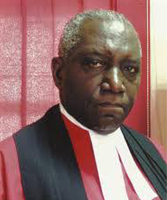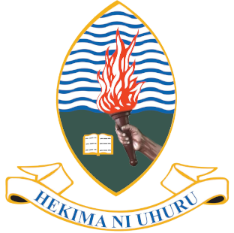
Barnabas Albert SAMATTA
YEAR OF MATRICULATION: 1963
EDUCATION:
The retired Chief Justice of Tanzania, Barnabas Albert Samatta, is an alumnus of the University of Dar es Salaam. He was born on 20 July 1940 into a formally educated family, whose head of household—his father Cuthbert—was a teacher. Barnabas had thus a chance of following in the footsteps of his dad, as is commonly the case with parental influence in many African homes, but this did not happen with him. Instead, Providence had had different plans for him. Sixty-seven years after his birth and some 57 years after entry to his first class of formal education, he was to retire from a bench that had made him one of the country’s fine statesmen, not only with a staunch belief in law and in the ‘rule of law’ but also with a farreaching practical bent for it.
Born in a village Ng’ombo in Mbinga district (in Ruvuma Region), he began his education at Ng’ombo Primary School, for an enhanced Standard 1-3, thereafter proceeding to Kilosa Native Authority School, close to Mbamba Bay, in 1953 for Std. 4-6. Then he moved to Songea Boys Secondary School for the lower stages of secondary education (1955-1956). From 1957 to 1962, he was admitted at Tabora Government Boys School, where he completed the senior classes of secondary education, popularly known then as the ‘A-Level’ or Cambridge Higher School Certificate. Given his exemplary performance in a multi-staffed, highly enabling school environment at Tabora School, Barnabas qualified for direct entry into university education in 1962. However, he ‘piggy-backed’ by taking up an interim engagement with the Mtwara District Court for a year, a factor that, in hindsight, may have played a catalyst behind his decisive interest in training as a lawyer at the country’s only College of the University of East Africa at Dar es Salaam in 1963. In the meanwhile, in the same year, he was awarded a scholarship to attend a course in African customary law at the School of Oriental and African Studies (SOAS) of the University of London in the UK. He graduated with an honours degree of Bachelor of Laws in 1966. He was immediately absorbed into government employment, being appointed a state attorney at the Attorney General’s Chambers in Dar es Salaam on 5 April 1966. A year later, in 1967, he was named assistant legal advisor to the Bermudian lawyer Dr. Earle E. Seaton in Arusha appointed then by President Nyerere to lead a Tanzanian legal counsel to the Tanzanian three-months delegation to the United Nations in New York. [Seaton had earlier defended the Meru of Arusha in a famous ‘Meruland case’ in which the people had been evicted from their ancestral pastoral land by order of the colonial government and, with Kirilo Japhet, had authored a book ‘Meru Land Case’ on the subject].
Mr. Samatta was subsequently appointed Senior State Attorney (1971-1972) and then Director of Public Prosecutions for Tanzania Mainland (1972-1976). Along with this, he served on the Judicial System Review Commission as a member from 1974 to 1977. He was appointed to the High Court of Tanzania as a judge in 1976, where he served for a total of 13 years until 1989. Within the same period of time, from 1984 to 1987, Judge Samatta served also in Zimbabwe (on loan from Tanzania) as a Judge of the High Court which had, until that time, been operating primarily under Roman Dutch Law. From 1989, he was appointed Principal Judge of the High Court of Tanzania, with an additional portfolio of membership to the Judicial Service Commission. From 2000, Judge Samatta was appointed Chief Justice of the United Republic of Tanzania and also Chairman of the Judicial Service Commission, the two positions he served for seven years until 2007 when he retired. It is worth of a note, however, that, for the two previous years, from 2005 to 2007, he had been honoured by an appointment to serve as vice-chairperson of the Southern African Judges Commission, an association of Chief Justices of the Southern African region. The Commission had been established to facilitate, among other things, closer cooperation and liaison among judges, in particular, Chief Justices in the region, as well as, in accordance with Section 178(5) of its Constitution, to advise their national governments on any matters relating to the Judiciary and to administration of justice.
Finally, it is worth noting that Judge Samatta’s stint as Chief Justice from 2000 to 2007 fell within a periodization of footsteps in a cohort of four previous chief justices of the country’s post-Independence period. He was immediately succeeding Francis Lucas Nyalali (1977–2000), who had been preceded by Augustino Saidi (1971–1977), Philip Telford Georges (1965–1971) and Ralph Windham (1964– 1965, 1960–1964*) [*designated as CJ of Tanganyika]. Justice Samatta was thus— so to speak among a new breed of post-independence articulators of the legal process and shapers of a post-colonial administration of the law. Readers might well wish to peruse a seminal account of his life and crusade for the law in ‘Rule of Law vs. Rulers of Law: Justice Barnaba Samatta’s Road to Justice’, ably compiled and edited by Issa Shivji and Hamudi Majamba (published by Mkuki & Nyota Publishers, Dar es Salaam, 2011, 257 pp.).
Judge Samatta currently serves as Chancellor of Mzumbe University, located in the municipality of Morogoro in Morogoro Region.

